From Yantian (鹽田) to Hamburg, world trade is in the doldrums and Christian Blauert, who heads the largest container terminal in Germany’s northern port of Hamburg, need only check the Web cams to knows things aren’t getting better.
On his computer he has access to a live-feed of pictures from Chinese harbors like Yantian showing mountains of empty containers, waiting for exports to pick up.
“The situation in the international port of Yantian is typical,” referring to the site near Hong Kong. “You can hardly see the full containers because the terminals are crowded with empties.”
The pictures illustrate that when the container ships come steaming into Hamburg from China, in six to seven weeks’ time after going round Africa to save paying Suez Canal transit fees, they will be carrying far fewer TV sets, bicycles, T-shirts and toothbrushes than at the same time last year.
At the HHLA (Hamburger Hafen und Logistik Aktiengesellschaft) Burchardkai terminal, where giant cranes on rails dominate the skyline, Blauert declines to say when business might pick up.
“It’s like navigating in the fog, you can only see what’s just ahead,” he says.
His firm expects turnover to be down by more than 10 percent this year because of the economic downturn and a number of HHLA’s 3,700 Hamburg employees will be facing short-time work as of this summer.
Axel Gedashko, economy minister in the city-state about 100km down river from the North Sea, does not mince his words: “The situation is dramatic,” he says.
“Trade in volume in the port of Hamburg is down by a quarter compared to last year” when nearly 10 million TEU (twenty foot equivalent unit), the figure used for calculating the number of containers shipped, went through the harbor, Gedashko says.
Shipping these days in Hamburg — Germany’s largest port and Europe’s second-largest after Rotterdam — is all about containers because 97 percent of goods are moved that way.
China was Hamburg’s most important trading partner last year, accounting for 32 percent in volume of the 140 million tonnes shipped through the port. Singapore came second, followed by Russia.
The world crisis “is hitting us badly because the port is at the center of logistics for northern Germany,” Gedashko says.
“And the situation here reflects the state of the world economy, not just in Hamburg and Germany, but for the whole of eastern Europe” because Hamburg, especially since the fall of the Iron Curtain, serves as the gateway for much of central and northern Europe, he says.
In this city-state of 1.8 million people, unemployment is up to 78,000, including 10,000 in the logistics sector, with at least 30,000 more on short-time, Gedashko says.
The city is worried. A poll by the Haspa bank showed 30 percent of firms connected with the harbor expect a bad year, 60 percent stagnation and just 6 percent think business will be good.

MULTIFACETED: A task force has analyzed possible scenarios and created responses to assist domestic industries in dealing with US tariffs, the economics minister said The Executive Yuan is tomorrow to announce countermeasures to US President Donald Trump’s planned reciprocal tariffs, although the details of the plan would not be made public until Monday next week, Minister of Economic Affairs J.W. Kuo (郭智輝) said yesterday. The Cabinet established an economic and trade task force in November last year to deal with US trade and tariff related issues, Kuo told reporters outside the legislature in Taipei. The task force has been analyzing and evaluating all kinds of scenarios to identify suitable responses and determine how best to assist domestic industries in managing the effects of Trump’s tariffs, he

TIGHT-LIPPED: UMC said it had no merger plans at the moment, after Nikkei Asia reported that the firm and GlobalFoundries were considering restarting merger talks United Microelectronics Corp (UMC, 聯電), the world’s No. 4 contract chipmaker, yesterday launched a new US$5 billion 12-inch chip factory in Singapore as part of its latest effort to diversify its manufacturing footprint amid growing geopolitical risks. The new factory, adjacent to UMC’s existing Singapore fab in the Pasir Res Wafer Fab Park, is scheduled to enter volume production next year, utilizing mature 22-nanometer and 28-nanometer process technologies, UMC said in a statement. The company plans to invest US$5 billion during the first phase of the new fab, which would have an installed capacity of 30,000 12-inch wafers per month, it said. The

Taiwan’s official purchasing managers’ index (PMI) last month rose 0.2 percentage points to 54.2, in a second consecutive month of expansion, thanks to front-loading demand intended to avoid potential US tariff hikes, the Chung-Hua Institution for Economic Research (CIER, 中華經濟研究院) said yesterday. While short-term demand appeared robust, uncertainties rose due to US President Donald Trump’s unpredictable trade policy, CIER president Lien Hsien-ming (連賢明) told a news conference in Taipei. Taiwan’s economy this year would be characterized by high-level fluctuations and the volatility would be wilder than most expect, Lien said Demand for electronics, particularly semiconductors, continues to benefit from US technology giants’ effort

‘SWASTICAR’: Tesla CEO Elon Musk’s close association with Donald Trump has prompted opponents to brand him a ‘Nazi’ and resulted in a dramatic drop in sales Demonstrators descended on Tesla Inc dealerships across the US, and in Europe and Canada on Saturday to protest company chief Elon Musk, who has amassed extraordinary power as a top adviser to US President Donald Trump. Waving signs with messages such as “Musk is stealing our money” and “Reclaim our country,” the protests largely took place peacefully following fiery episodes of vandalism on Tesla vehicles, dealerships and other facilities in recent weeks that US officials have denounced as terrorism. Hundreds rallied on Saturday outside the Tesla dealership in Manhattan. Some blasted Musk, the world’s richest man, while others demanded the shuttering of his